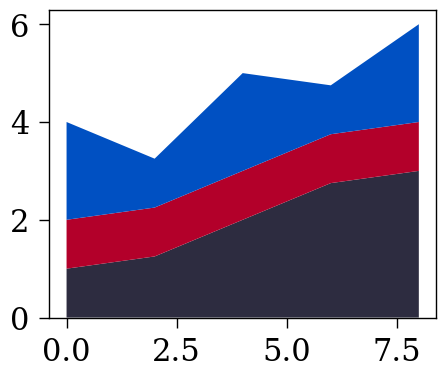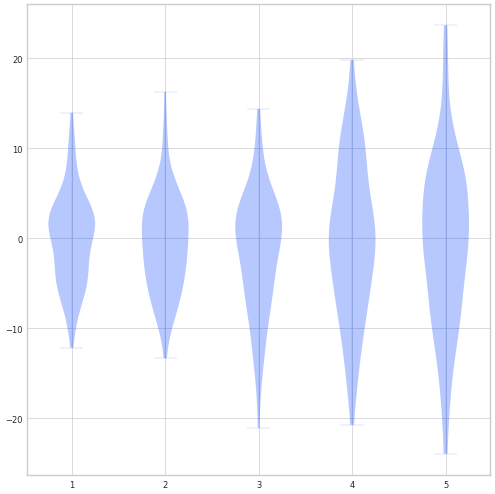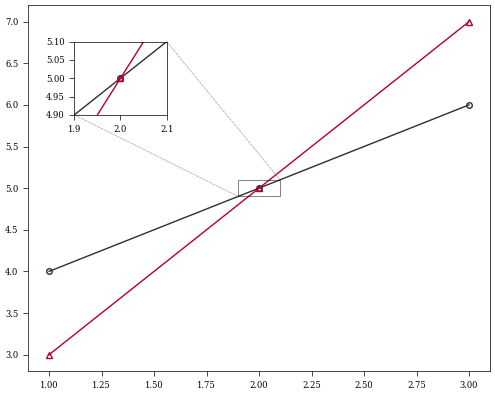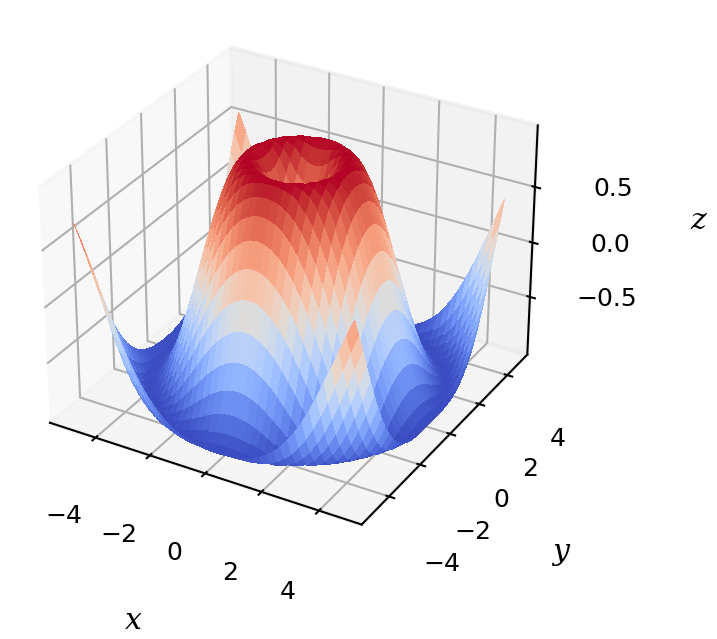FreePlot is a Python data visualization library based on Matplotlib. It provides some simple implementations according to my preference. Matplotlib is powerful yet not easy to draw what you want due to its complicated arguments. I feel FreePlot is more friendly, especially for papers.
pip install freeplot
- import
from freeplot.base import FreePlot
- create a new container
fp = FreePlot(shape=(2, 2), titles=('a', 'b', 'c', 'd'), sharey=True)
shape: the arrangement of axes, 2 x 2, a total 4 axes in this case;
figsize: (height, width), the real figure size here is 400 x 440;
titles: the title for each ax;
sharey: axes will share the y axis if true.
the container can be used in a ndarray-style, e.g.:
# fp[0, 0], fp[0, 1]
You can also use title:
# fp['a']
But the slice operation is not supported:
# fp[:, 0]
- plotting
I implement some methods for plotting such as lineplot, scatterplot ...
fp.lineplot(x=[1, 2, 3], y=[4, 5, 6], index=(0, 0), label='test')
- set xlabel, ylabel
use
fp.set_label('X', axis='x', index=(0, 0))
fp.set_label('Y', axis='y', index=(0, 0))
or
fp.set(xlabel='X', ylabel='Y', index=(0, 0))
- set title
fp.set_title(y=0.98) # for all axes
- save your fig
fp.savefig('test.pdf')
Let's do a little complicate plotting.
import numpy as np
import pandas as pd
from freeplot.base import FreePlot
titles = ('Line', 'Scatter', 'Bar', 'Heatmap')
fp = FreePlot(shape=(2, 2), titles=titles, sharey=False)
# Line
x = np.linspace(0, 2, 10)
y1 = x ** 0.5
y2 = x ** 2
fp.lineplot(x, y1, index=(0, 0), style='line', label='sqrt(2)')
fp.lineplot(x, y2, index=(0, 0), style='line', label='pow(2)')
fp[0, 0].legend()
# scatter
x = np.random.randn(100)
y = np.random.randn(100)
fp.scatterplot(x, y, index='Scatter', style='scatter')
fp.set_label('X', index=(0, 1), axis='x')
fp.set(ylabel='Y', index=(0, 1))
# bar
A = [1., 2., 3.]
B = [2., 3., 4.]
T = ['One', 'Two', 'Three'] * 2
Hue = ['A'] * len(A) + ['B'] * len(B)
data = pd.DataFrame(
{
"T": T,
"val": A + B,
"category": Hue
}
)
fp.barplot(x='T', y='val', hue='category', data=data, index=(1, 0), auto_fmt=True)
# Heatmap
row_labels = ('c', 'u', 't', 'e')
col_labels = ('l', 'r', 'i', 'g')
data = np.random.rand(4, 4)
df = pd.DataFrame(data, index=col_labels, columns=row_labels)
fp.heatmap(df, index='Heatmap', annot=True, fmt=".4f", cbar=False, linewidth=0.5)
# set titles
fp.set_title(y=0.98)
# savefig
fp.savefig('demo.png')
# fp.show()
import numpy as np
import matplotlib.pyplot as plt
import seaborn as sns
from freeplot.base import FreePlot
x = np.arange(0, 10, 2)
ay = [1, 1.25, 2, 2.75, 3]
by = [1, 1, 1, 1, 1]
cy = [2, 1, 2, 1, 2]
y = np.vstack([ay, by, cy])
fp = FreePlot()
fp.stackplot(x, y, index=(0, 0), style='stack')
fp.show()
import numpy as np
from freeplot.base import FreePlot
from freeplot.zoo import pre_radar, pos_radar
labels = (
"brightness", "fog", "gaussian_blur", "glass_blur", "jpeg_compression",
"motion_blur", "saturate, snow", "speckle_noise", "contrast", "elastic_transform", "frost",
"gaussian_noise", "impulse_noise", "pixelate", "shot_noise", "spatter", "zoom_blur", "transform", "flowSong"
)
theta = pre_radar(len(labels), frame="polygon")
# shape: 1, 1; figsize: 4, 4;
fp = FreePlot((1, 1), (4, 4), dpi=100, titles=["RADAR"], projection="radar")
fp.set_style('no-latex')
data = {
"A": np.random.rand(len(labels)),
'B': np.random.rand(len(labels)),
'C': np.random.rand(len(labels))
}
pos_radar(data, labels, fp, index=(0, 0), style='bright')
fp[0, 0].legend()
fp.savefig("radar.png", tight_layout=True)
import numpy as np
import matplotlib.pyplot as plt
from freeplot.base import FreePlot
fp = FreePlot((1, 1), (5, 5))
# note that each element is a group of data ...
all_data = [np.random.normal(0, std, 100) for std in range(5, 10)]
fp.violinplot(x=None, y=all_data, index=(0, 0))
fp.savefig('violin.png')
from freeplot.base import FreePlot
fp = FreePlot((1, 1), (4, 5))
fp.lineplot([1, 2, 3], [4, 5, 6], label='a')
fp.lineplot([1, 2, 3], [3, 5, 7], label='b')
axins, patch, lines = fp.inset_axes(
xlims=(1.9, 2.1),
ylims=(4.9, 5.1),
bounds=(0.1, 0.7, 0.2, 0.2),
index=(0, 0),
style='line' # !!!
)
fp.lineplot([1, 2, 3], [4, 5, 6], index=axins)
fp.lineplot([1, 2, 3], [3, 5, 7], index=axins)
fp.savefig('inset.png')
import numpy as np
import matplotlib.pyplot as plt
from freeplot.base import FreePlot
X = np.arange(-5, 5, 0.25)
Y = np.arange(-5, 5, 0.25)
X, Y = np.meshgrid(X, Y)
R = np.sqrt(X**2 + Y**2)
Z = np.sin(R)
fp = FreePlot(projection='3d', dpi=300) # projection: '3d' !!!
fp.surfaceplot(X, Y, Z, cmap=plt.cm.coolwarm, antialiased=False, linewidth=0)
fp.set_label(r"$x$", axis='x')
fp.set_label(r"$y$", axis='y')
fp.set_label(r"$z$", axis='z')
fp.show()
We turn off the 'latex' option by default to speed up. You can activate it by (make sure that Latex is accurately installed on your computer)
fp = FreePlot(latex=True)
You shall use the following to close it halfway,
fp.set_style('no-latex')
or
plt.style.use('no-latex')
-
For lineplot, barplot ..., you can directly use matplotlib.axes._axes.Axes as index, e.g.:
fp.lineplot(x, y, index=fp[0, 0]) -
You may find some interesting implementations in freeplot.zoo, such as tsne, roc_curve ...
-
You can use a list of styles:
fp.set_style(['bright', 'high-vis', {"axes.facecolor":".9"}]) -
It would be better to use
fp.legendto set legend instance instead of
fp[0, 0].legend -
You can find all available styles by
fp.styles -
You can scale x|y-axis by
fp.set_scale(value='symlog', index=(0, 0), axis='x') fp.set_scale(value='symlog', index=(0, 0), axis='y') -
You can add text on Axes by
fp.set_text(x, y, s, fontsize=10) -
You can create Patches by FreePatches and add them by
fp.add_patch(patch)





